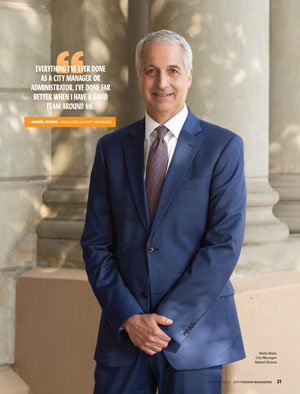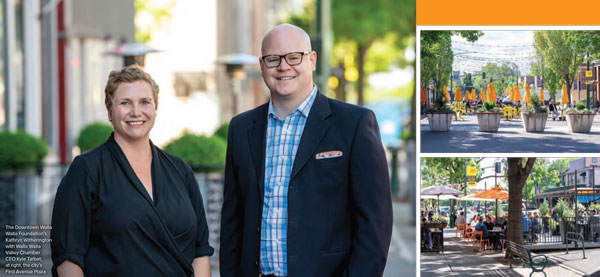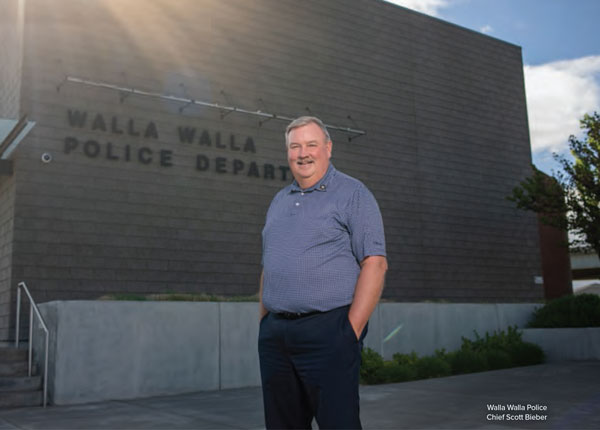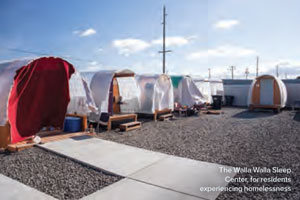By Devon O’Neil
Nabiel Shawa has always felt drawn to Walla Walla, a city that seemed to radiate potential, both economically and culturally. After growing up in Long Beach, a coastal town of 1,400, he owned a cranberry farm there in his 20s, and when the municipality
needed an administrator in 1983, he took the job. Then he sold his cranberry farm—partly due to a drop in the market, but mostly because he liked running a city more than he liked growing cranberries.

After serving his hometown in that role for more than two decades, in 2004 Shawa moved up the Columbia River to the City of Washougal. Managing that city by day while commuting across the I-5 bridge for postgraduate coursework in public administration
at Portland State University, he never stopped thinking about the midsize gem in southeastern Washington, with its diversified economy, famously friendly residents, and some of the best wine in America.
“I’d had my eye on Walla Walla and knew I wanted to apply if the timing was correct,” Shawa says. In 2009, it was. He became Walla Walla’s city manager at the height of the Great Recession, inheriting a financial situation so dire
he laid off 47 full-time staff in the first year to stanch the bleeding—and put the city on a strict fiscal diet until its budget stabilized.
When Shawa was administering Long Beach after the dot-com bust, the city had courted tourists from Seattle who, it turned out, were eager to spend their leisure dollars closer to home. In Walla Walla, he helped promote a similar approach during its recovery:
partnering with local business leaders to position Walla Walla as a destination for oenophiles and epicures rivaling Napa and Sonoma. “In a crisis, it’s easy to back off,” he says. “What I found was it was better to lean forward
and accelerate.”
Before long, Walla Walla—a 19th-century agricultural hub-turned–tourism hotbed—was back on the upswing. And with a population of 34,000 and an annual budget of around $120 million, the city continued its legacy of doing most everything
on its own.
“It’s the most full-service city I’ve ever worked for,” Shawa says. “Many cities our size don’t operate their own libraries or garbage collection or have a city-owned landfill. Really what that speaks to is the remoteness
of Walla Walla. If residents wanted these services back in the day, they had to provide them.”
That by-the-bootstraps resolve would serve the city well when, in early 2020, nearing the end of his career at age 63, Shawa suddenly faced his first pandemic. And a devastating flood. And a social-justice maelstrom. All in the span of a few months. Walla
Walla’s remote location couldn’t protect it from facing the same strains that cities across the state and the nation had to contend with.
The city navigated the pandemic year of 2020 without having to lay off any of its 283 full-time employees while socking away a $6.3 million reserve fund. To accomplish that feat, city leadership drew heavily on a management tool known as the Baldrige
Criteria for Performance Excellence, a framework of core values and principles (named for former U.S. Secretary of Commerce Malcolm Baldrige) enshrined in a 1987 federal law that created an organizational blueprint for how US manufacturing businesses
could compete better in a global economy (see “Doing Your Framework,” p. 25). Following Baldrige’s fourth core value, Valuing People, Walla Walla prioritized recruitment and hiring during the pandemic. As Shawa notes, “Everything
I’ve ever done as a city manager or administrator, I’ve done far better when I have a good team around me.”
Everything I’ve ever done as a city manager or administrator, I’ve done far better when I have a good team around me.
– Nabiel Shawa, Walla Walla City Manager
Perhaps even more critical to his city’s success in navigating the yearlong crisis, Shawa says, was its key staff and electeds’ ability to model the second Baldrige principle, Visionary Leadership: “Your organization’s senior leaders
should set a vision for the organization, create a customer focus, demonstrate clear and visible organizational values and ethics, and set high expectations for the workforce.”

Walla Walla’s season of leadership challenges began in January 2020 with the shuttering of Macy’s, a landmark downtown department store that since 1920 had been a key contributor to the city’s tax coffers. Of course,
when it rains in Washington, it pours, and in February that came true literally: an epic Mill Creek flood fractured a mile of the city’s three-foot-wide water pipeline, leaving the city’s public works staff scrambling to keep the taps
running via deep wells for two months—and cover a $1.3 million repair bill. (Ultimately, the city declared an emergency, and FEMA funded the project.)
Then the Covid-19 pandemic unleashed its own natural disaster. On March 17, Walla Walla’s city council declared another citywide emergency, closing city hall to the public as the novel health threat bore down on global society and local communities
alike. With no precedent to analyze, Shawa and his staff braced for the worst. Walla Walla’s goal is always to have 15 percent of its roughly $35 million in annual General Fund expenditures in reserve, he says. Going into the pandemic, the city
was right about on track, having saved $5.2 million—enough for a small cushion before panic set in. Staff modeled five potential pathways forward, from best-case scenario to worst. The team desperately wanted to avoid laying off staff, so Shawa
decided to delay that step until the reserves reached 10 percent. In addition to postponing or slowing previously planned and funded projects, the city froze 13 vacancies, saving around $1 million including benefits, then waited and hoped that the
numbers would stabilize.
A week later, when the governor’s Stay Home Stay Healthy order shuttered all nonessential businesses, the city’s sales and lodging tax revenues plunged, but thanks to CARES Act funding ($1.02 million) and an unexpected surge in day-trip tourism,
the plan worked. Reserves never touched 10 percent. The city partnered with the Port of Walla Walla and Walla Walla County to distribute grants to more than 300 local businesses and produced three live videos per week to keep citizens informed.
Collaboration permeated every aspect of the response politically, too. Taking another cue from the Baldrige framework (Societal Contributions: “Your leaders should be role models for the well-being of your communities”), the city council—which
is made up of seven community members with widely varying backgrounds (including two elementary school teachers and an attorney), a diverse generational mix (from millennials through retirees), and disparate political beliefs—did something unique
when Covid case numbers spiked: they all took a pledge to wear masks in public, even though some disagreed with the idea. Later, when cases surged again, Walla Walla’s mayor partnered with the mayor of neighboring College Place to deliver a
soberly worded countywide message on the importance of compliance.
Meanwhile, finances rebounded faster than anticipated, and the cty’s tough decisions at the start of spring had proved prudent. “Initially we took a significant hit,” Shawa says, “but then we bounced back, and by early third quarter
we were on a pathway that exceeded our best, hoped-for model. And that’s where we finished the year.” Instead of being $2 million down from 2019’s $6.2 million in sales tax revenue, as city leaders had projected in their doomsday
model, Walla Walla finished 2020 at $5.9 million—a drop of only 5 percent.
Much of that magic happened out of view, catalyzed by regular brainstorming sessions among city leadership staff, Mayor Tom Scribner, and Mayor Pro Tem Steve Moss. But a lot of it originated on the streets, too, via the principle of Management By Walking
Around. A few years ago, Shawa had invited councilmembers to join him and city staff as they strolled the streets and talked to business owners. “They thought I was crazy, that we’d get screamed at,” Shawa says. But it worked then,
and it worked again when the pandemic hit, as a way of taking the city’s pulse—with Walla Walla’s business community taking much of the initiative upon itself.
Kathryn Witherington was a prime player in bringing solutions to life. She’d only been executive director of the Downtown Walla Walla Foundation for a month when the hopping commercial district turned into a sad grid of empty streets and shuttered
shops. “It was kind of a crazy time to come in,” Witherington says, “but I really thrive when I can help people.”

The city’s economy is largely driven by wine—more than 120 wineries are based in the valley, where they welcome a half-million visitors, account for $146 million in spending, and provide 2,484 jobs. But it is also a regional hub for government.
The Army Corps of Engineers has a three-state headquarters here; a state penitentiary employs approximately 1,500 people; and the Department of Veterans Affairs has both a base and a hospital. (There are also three higher-education institutions in
Walla Walla, most notably Whitman College.) In addition, wheat and onions remain prime agricultural commodities grown in the area—and they spur local spending. “When wheat is priced high, and they’ve got a great harvest in, our car
and furnishing sales do go up,” Shawa says.
The Downtown Foundation’s mission is to promote the business center’s history, culture, and commerce. It is funded primarily by a Main Street tax-credit incentive program, which allows businesses to donate money in exchange for tax breaks.
As soon as it became clear that businesses were existentially threatened by the pandemic, Witherington and others—notably the Walla Walla Valley Chamber of Commerce and Visit Walla Walla, the city’s destination marketing organization—launched
a number of pointed measures to stem the bleeding, from a Think Local campaign to a Peace of Mind Pledge for local businesses to meet or exceed government safety protocols. In addition, the city, the Chamber, and the Downtown Foundation partnered
to host a series of weekly town-hall meetings to provide local business owners with updated information about the pandemic and available resources.
“More than once I was just loading up my pickup and driving up and down the street, dropping off masks and sanitizer at every business,” says Walla Walla Valley Chamber of Commerce CEO Kyle Tarbet. “And that gave me the opportunity to
follow up with every owner and ask them, ‘What do we not know about your specific industry?’ Then I would share some of our best practices.”
The biggest challenge for wine-tasting rooms and restaurants—roughly 60 of which are among the city’s 419 downtown businesses—was a lack of infrastructure to expand outdoors. With help from the CARES Act, the city and the Downtown Foundation
introduced “streeteries,” their name for eateries on the street. City council approved code changes to allow restaurants to use Walla Walla’s wide sidewalks and curbside parking spaces to create parklets that would provide more space
for socially distanced outdoor dining (with the city providing materials and businesses paying for labor to build the parklets). Witherington worked with the liquor control board to allow eateries an extra two or three tables there. In addition, the
city and the foundation purchased 400 tables and 1,600 chairs for any business in need of outdoor seating. “We got them to a place where they could break even, and in some cases even flourish,” Witherington says.
We got them to a place where they could break even, and in some cases even flourish.
– Kathryn Witherington, Downtown Walla Walla Foundation Executive Director
The collaboration extended into the private sector. Retailers allowed restaurants to build streeteries in front of their stores, betting—correctly—that the move would benefit both. But the “biggest, flashiest” move, Witherington
says, was a novel concept dubbed First Avenue Plaza. The city shut down an entire street and filled it with uniform seating and overhead café lighting, creating a place for people to dine, imbibe, and mingle safely outdoors. “We basically
created an awesome community center with a neighborhood feel that we’ve lacked in our downtown core,” Witherington says, adding that it is likely to become permanent. “I can’t wait to program it.”
The city didn’t market its streeteries, fearing an overwhelming swell of visitors, but social media filled that void and helped populate it with manageable crowds. Meanwhile, Tarbet and his staff lobbied the governor’s office and federal representatives
to eliminate restrictions that hurt sole proprietors or new businesses, opening up the next round of public funding to more establishments in Walla Walla.
In all, Witherington says 11 downtown businesses were forced to close due to the pandemic, including three salons and a coworking space. But 14 new ones opened, five of which were eateries. Throughout the tough times, she’s watched competing restaurants
support each other with extra supplies or a weekly lunch order for employees. “It’s the Walla Walla way,” she says.
Overall, the mood downtown has changed. “For a while it did feel really hopeless; we lost sight of the end of the tunnel,” Witherington says. “But it’s better now. People are feeling hopeful again.”

Scott Bieber can relate to that roller coaster. As Walla Walla’s police chief for nine years and a peace officer for most of his life, he thought he’d seen the gamut. Then came 2020. “This past year has been the most
stressful of my 36-year career,” he says.
For the first few months, his challenges were more or less predictable: shuffling his schedule as officers tested positive for COVID, managing budget constraints, and weighing the need to enforce discretionary contacts like traffic stops with the threat
of exposure. Then in June, with downtown reopened and buzzing, the national Black Lives Matter movement streamed into Walla Walla with a series of peaceful protests. The protesters were “very respectful,” Bieber says. “I think the
biggest crowd we had downtown was probably 800 people. I wanted to protect everybody’s First Amendment rights and make sure they were able to exercise those rights peacefully.”
During that movement, however, someone posted a photo on social media of one of Bieber’s officers, Nat Small, and a tattoo on Small’s forearm that bore a striking resemblance to the infamous Nazi “SS” insignia. The local outrage
quickly became a cauldron of controversy and division. It was ultimately a misunderstanding: Small’s tattoo, which he had gotten nearly a decade earlier, paid homage to one of his fallen comrades in the Marine Corps’ Scout Sniper division
(hence the double “S”), Claudio Patino IV, who was killed at Small’s side during a firefight in Afghanistan in 2010.
At a time when each political side sought means to support its views, Small’s perceived anti-Semitic emblem delivered. Whitman College’s president, Kathleen Murray, announced that the liberal arts school would no longer hire Walla Walla police
officers for event security. Protesters pressured Bieber to fire Small or, at the very least, force him to alter his tattoo (department policy requires only that any tattoo that might be construed as offensive be covered up during duty).
“I was villainized,” Bieber says, “but I thought, you know, here’s a guy whose friend died in his arms; he almost died himself protecting everybody’s First Amendment rights. Don’t we have a responsibility to offer him
the same thing?”
As the furor swirled, Bieber called a friend who knew recently retired four-star general James Mattis, the former Secretary of Defense who lived in a town nearby. Within a half hour, Bieber’s phone rang. “Chief,” the caller said, “Jim
Mattis here. What can I do for you?”
Mattis had already done some research about the controversy. Bieber asked the general, “Would you mind coming over and having a conversation with Nat?”
“Sure,” Mattis replied. “What do you want me to say?” Bieber said that was up to Mattis.
Mattis drove to Walla Walla the next day and, according to Bieber, had a long, constructive talk with Small. A few days later, Small decided to alter the tattoo and released a heartfelt statement explaining why.
It read, in part: “Every good thing I do brings credit to [Patino’s] unselfish actions that allow me to be here today. In that sense, I am the truest memorial to my brother, Claudio. At one point, the tattoo on my arm was so important to me,
that in my young mind, I would have done anything to keep it. I would have let pride interfere with my success, and I would have let it inhibit my ability to help others. I have seen my community divided, with good people on both sides of the aisle.
Neighbors have turned against each other and people are refusing to do business with those whose opinions differ. I regret that I have been an unwitting cause of division in the community that I seek to serve. For those reasons, I have decided to
alter my tattoo to eliminate the ‘Double S’ portion. I have not been forced or compelled to make this decision by my superiors at the Walla Walla Police Department or the City of Walla Walla.”
In addition, Bieber joined Shawa and Mayor Scribner in a three-part virtual town hall to explain the department’s policies and respond to citizen comments. The city council convened and hosted the special meetings. At the finale , Bieber condemned
racism and said his department was banning a controversial neck restraint technique and would look into purchasing dash and body cams in the name of transparency.
“My favorite quote,” Bieber says, as a way of reinforcing his priorities, “is: ‘The culture of any organization is shaped by the worst behavior the leader is willing to tolerate.’” In a period of a few trying months,
he seemed to have honored that principle in more ways than one.
My favorite quote is: ‘The culture of any organization is shaped by the worst behavior the leader is willing to tolerate.’
– Scott Bieber, Walla Walla Police Chief
By April 2021, optimism permeated Walla Walla. USA Today named the city the premier winemaking region in America. Shawa says early sales tax numbers hint at this year being the city’s best ever—even with the community still officially in a
state of emergency. “Just as the onset was unprecedented, the rebound was unprecedented, too,” he says. “I’ve never seen anything like it. We’re coming back like a rocket ship.”
Thanks to booming direct-to-consumer sales that largely offset the loss of in-person tasting-room business, along with a promising pandemic-year grape harvest, many in the local wine industry believe they have weathered the worst of the storm. “We’ve
pushed the person in front of us and pulled the person behind us,” says Walla Walla Valley Wine Alliance Executive Director Robert Hansen. “The 2020 vintage will be memorable for many reasons, including the quality of the grapes grown
and the wines produced during this unprecedented time.”
“Everyone was really thankful for everything the city did to help its businesses. They didn’t sit on their hands at all,” says Hoquetus Wine Company owner Robert Gomez, who launched his local winery in 2020. “If I can survive this,
I feel like I can survive almost anything. And I think a lot of people have that feeling.”
The city council passed a biannual budget last fall of $245 million—right on track with pre-pandemic budgets. In it, the council addressed policing concerns and took input from the Chief’s Advisory Committee, a resident-led work group advising
the city on law enforcement response. The budget came with a significant cut to the police department’s funding (only one out of four open positions was to be filled), but the council also approved a separate budget for social service concerns
related to law enforcement.
 In December, the council earmarked $190,000 to continue its support of the Sleep Center, a tent city alternative that provides pod housing (in 37 weatherproof huts resembling Conestoga wagons) for citizens experiencing homelessness as a result of the
pandemic. And Shawa says Walla Walla is trying to further diversify its economy by pursuing up to a dozen national concert acts annually and hosting shows at the municipal golf course, repurposed as an outdoor music venue dubbed “Range Amphitheater.”
In December, the council earmarked $190,000 to continue its support of the Sleep Center, a tent city alternative that provides pod housing (in 37 weatherproof huts resembling Conestoga wagons) for citizens experiencing homelessness as a result of the
pandemic. And Shawa says Walla Walla is trying to further diversify its economy by pursuing up to a dozen national concert acts annually and hosting shows at the municipal golf course, repurposed as an outdoor music venue dubbed “Range Amphitheater.”
For the city manager whose career arc from cranberry bogs to wine country seems an uncanny complement to Walla Walla’s resiliency and adaptability, reflection came with the season. The sun was shining longer. Grapes were growing. Business was
picking up. “Frankly,” Shawa says, “I’m kind of shocked we’re in such a good place. It’s bizarre. I roll the clock back 10 months, and I never would’ve dreamed that we’d be where we are today. But
as the saying goes, ‘Never let a crisis go to waste.’”